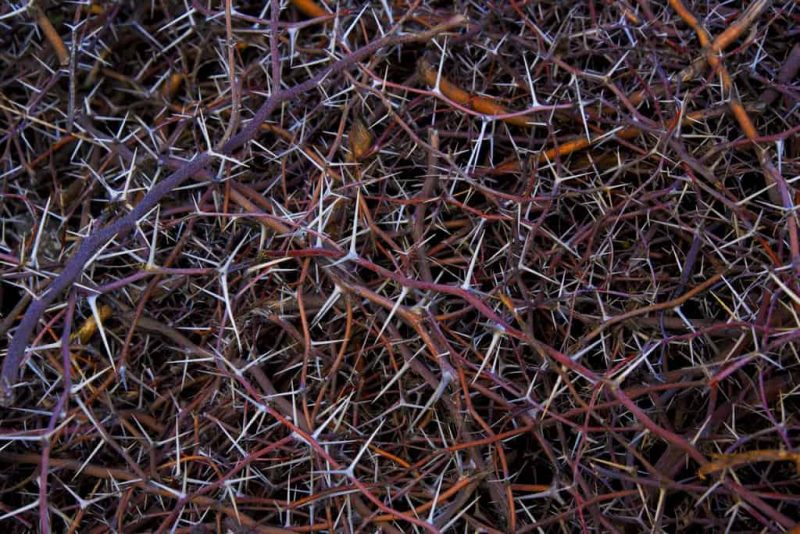If you’re interested in learning how to propagate crown of thorns, you can do so by seeds or cuttings. Crown of thorns or Euphorbia milii is an exciting succulent to add to the garden. Therefore, it’s useful to know how to propagate it and start from whichever you think is more convenient.
The good news is that this variety of euphorbia already puts you at a head start by being generally easy to propagate. Unlike other plant types, the Christ plant is not susceptible to many challenges from propagation. You can also guarantee the establishment by starting this plant in the greenhouse because the environment is optimal for young plants to develop.

How To Propagate Crown Of Thorns For Beginners
Option #1. Seeds
Pollination and seed collection
The first option for propagating a crown of thorns is from seeds. You can buy the seeds, but it’s possible to pollinate them yourself if you have existing plants. You do this by transferring pollen from one flower to another with a fine paintbrush.
The crown of thorns plant should develop a capsule that you’ll wait until to ripen. Once this happens, please remove it from the plant and split over a paper sheet for seed collection. However, unlike other plants, note that the seeds of Christ plants are not suitable for extended storage periods.
Sowing and germination
Instead, sow the seeds immediately at the surface of a well-draining medium in flats. In general, this plant tolerates low-quality soil, but you can create a seed starting mix from soil, peat moss, sand, and perlite. Cover the seeds with sand lightly and maintain moisture.
To help with germination, cover the container with plastic and place in the greenhouse where it’s bright but out of direct sunlight. Use the greenhouse to your advantage and maintain the temperature around 65 to 75°F.
As the seeds germinate within two to three weeks, remove the cover and maintain the surface moisture. You can then transplant outdoors when the crown of thorns plants develop a set of true leaves.
Option #2. Cuttings
The second option and perhaps the most preferred gardeners method is propagating a crown of thorns from cuttings. However, caution is necessary for this technique because this plant has sharp spines and slightly toxic sap. NC State University recommends letting the sap dry before placing it in the growing medium.
Collecting and drying
To gather cuttings from a crown of thorns plant safely, make sure to protect yourself with thick gloves. You also want to use a sharp and sterilized knife and slice through the plant’s stem around 4 inches back from its tip. Rinse the cutting and dip the end in rooting hormone powder.
This way, the sap stops flowing, and you can let the cutting dry in a paper towel. The reason for drying the cutting is to prevent it from potentially rotting. Select an area that is warm and dry, and you’ll know when the cutting is ready if it looks puckered.
Planting and care
The cutting should thrive well in a fast-draining mix of potting soil and sand, making sure that it is stable at the pot’s center by firming the medium around it. Place the container where it’s warm and dry but out of direct sunlight, and maintain the greenhouse temperature above 70°F to guarantee establishment. As with seeds, always check the medium and water if necessary.
Did you know that you can also root a crown of thorns cutting in water? Start the cutting in a glass with around an inch of water to engulf its tip. Please place it in a similar location as potted cuttings and repot once the roots develop.
Caring For Crown Of Thorns
Crown of thorns plants are generally easy to care for. You want to water them only when the soil is dry by flooding the pot and letting the water drain underneath. You can water the crown of thorns plants from spring to fall, and they can also receive water in winter if the soil is dry three inches deep.
How to feed the crown of thorns plants? Throughout the year, a liquid fertilizer would work well with crown of thorns plants where you feed them every two weeks in summer, spring, and fall. For winter, make sure that you only do so monthly with diluted fertilizer.
Conclusion
Crown of thorns is one of the most beautiful and easy-to-care-for succulents you can have in the garden. Learning how to propagate crown of thorns will allow you to start either from seeds or use cuttings to grow this unique plant. If you opt to sow seeds, remember that they are only viable for a short period.
You need to immediately use the seeds and place them in the greenhouse to guarantee germination. This includes covering the container to maintain moisture and ensuring that the temperatures are between 65 to 75°F. On the other hand, you can take cuttings from an existing plant, given that you are extra careful with the thorns and sap.
You treat the cutting as you would with any plant, but let it dry first before planting to lower the rot risk. Dip it in rooting hormone powder and place somewhere bright but not receiving direct sunlight. You can also root crown of thorns cuttings in water, but whichever propagation method you choose, the greenhouse makes it easy to create an optimal growing environment.
